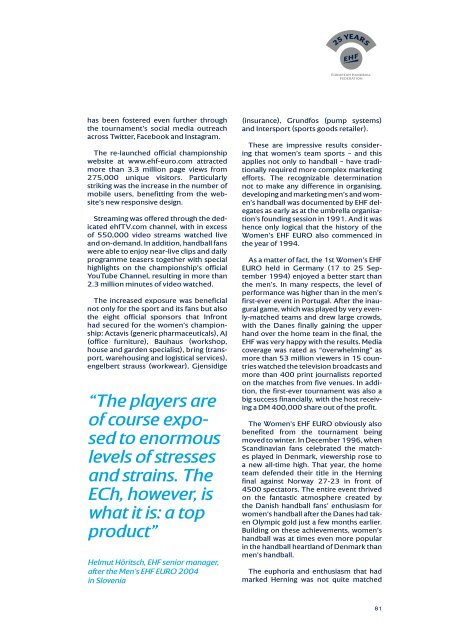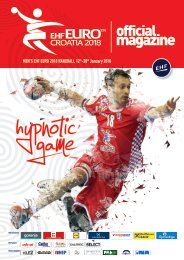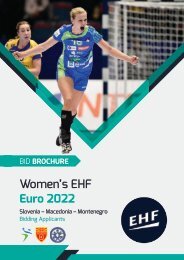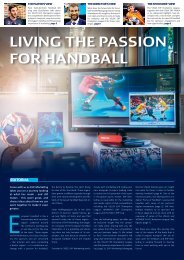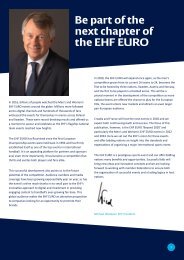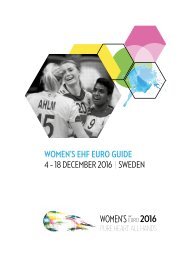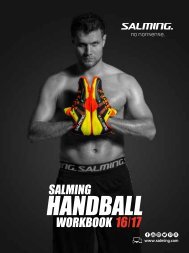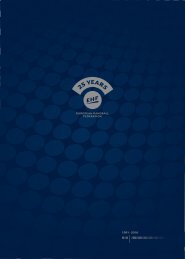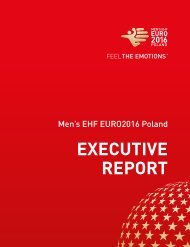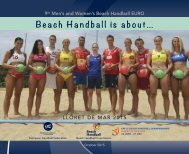ehf_25yers_book_webversion (1)
You also want an ePaper? Increase the reach of your titles
YUMPU automatically turns print PDFs into web optimized ePapers that Google loves.
has been fostered even further through<br />
the tournament’s social media outreach<br />
across Twitter, Face<strong>book</strong> and Instagram.<br />
The re-launched official championship<br />
website at www.<strong>ehf</strong>-euro.com attracted<br />
more than 3.3 million page views from<br />
275,000 unique visitors. Particularly<br />
striking was the increase in the number of<br />
mobile users, benefitting from the website’s<br />
new responsive design.<br />
Streaming was offered through the dedicated<br />
<strong>ehf</strong>TV.com channel, with in excess<br />
of 550,000 video streams watched live<br />
and on-demand. In addition, handball fans<br />
were able to enjoy near-live clips and daily<br />
programme teasers together with special<br />
highlights on the championship’s official<br />
YouTube Channel, resulting in more than<br />
2.3 million minutes of video watched.<br />
The increased exposure was beneficial<br />
not only for the sport and its fans but also<br />
the eight official sponsors that Infront<br />
had secured for the women’s championship:<br />
Actavis (generic pharmaceuticals), AJ<br />
(office furniture), Bauhaus (workshop,<br />
house and garden specialist), bring (transport,<br />
warehousing and logistical services),<br />
engelbert strauss (workwear), Gjensidige<br />
“The players are<br />
of course exposed<br />
to enormous<br />
levels of stresses<br />
and strains. The<br />
ECh, however, is<br />
what it is: a top<br />
product”<br />
Helmut Höritsch, EHF senior manager,<br />
after the Men’s EHF EURO 2004<br />
in Slovenia<br />
(insurance), Grundfos (pump systems)<br />
and Intersport (sports goods retailer).<br />
These are impressive results considering<br />
that women’s team sports – and this<br />
applies not only to handball – have traditionally<br />
required more complex marketing<br />
efforts. The recognizable determination<br />
not to make any difference in organising,<br />
developing and marketing men’s and women’s<br />
handball was documented by EHF delegates<br />
as early as at the umbrella organisation’s<br />
founding session in 1991. And it was<br />
hence only logical that the history of the<br />
Women’s EHF EURO also commenced in<br />
the year of 1994.<br />
As a matter of fact, the 1st Women’s EHF<br />
EURO held in Germany (17 to 25 September<br />
1994) enjoyed a better start than<br />
the men’s. In many respects, the level of<br />
performance was higher than in the men’s<br />
first-ever event in Portugal. After the inaugural<br />
game, which was played by very evenly-matched<br />
teams and drew large crowds,<br />
with the Danes finally gaining the upper<br />
hand over the home team in the final, the<br />
EHF was very happy with the results. Media<br />
coverage was rated as “overwhelming” as<br />
more than 53 million viewers in 15 countries<br />
watched the television broadcasts and<br />
more than 400 print journalists reported<br />
on the matches from five venues. In addition,<br />
the first-ever tournament was also a<br />
big success financially, with the host receiving<br />
a DM 400,000 share out of the profit.<br />
The Women’s EHF EURO obviously also<br />
benefited from the tournament being<br />
moved to winter. In December 1996, when<br />
Scandinavian fans celebrated the matches<br />
played in Denmark, viewership rose to<br />
a new all-time high. That year, the home<br />
team defended their title in the Herning<br />
final against Norway 27-23 in front of<br />
4500 spectators. The entire event thrived<br />
on the fantastic atmosphere created by<br />
the Danish handball fans’ enthusiasm for<br />
women‘s handball after the Danes had taken<br />
Olympic gold just a few months earlier.<br />
Building on these achievements, women’s<br />
handball was at times even more popular<br />
in the handball heartland of Denmark than<br />
men’s handball.<br />
The euphoria and enthusiasm that had<br />
marked Herning was not quite matched<br />
81


